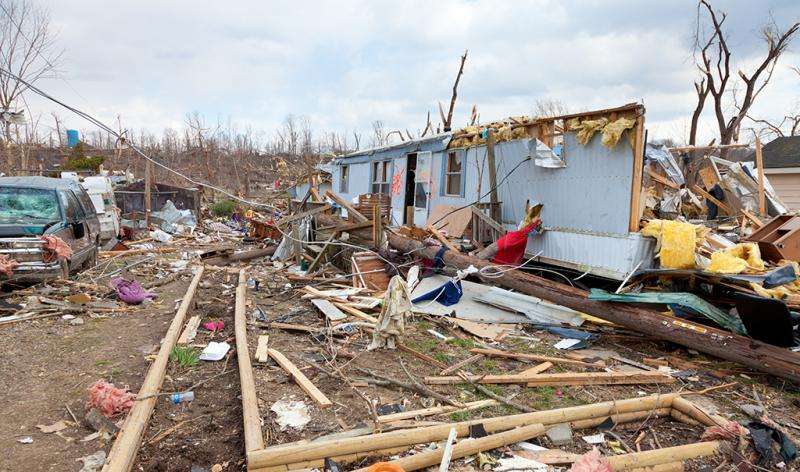Climate change, tornadoes and mobile homes—a dangerous mix

Tornadoes and mobile homes don't mix to begin with, but throw in the volatility of climate change and the potential for massive property damage and deaths is even higher in coming decades, indicates a new study by Michigan State University researchers.
The number of mobile homes in the United States has risen dramatically in the past 60 years, to about 9 million currently. Meanwhile, the U.S. is the most tornado-prone country in the world, with an average of 1,200 twisters per year, and scientists predict climate change will continue fueling more unstable weather events including tornadoes.
The annual impact of tornadoes is expected to increase threefold over the next few decades due to the "twin forces of increased climate variability and growth in the human-built environment," according to the study, which is published online in the journal Regional Science and Urban Economics.
"If the climatologists are right about the continuing effects of climate change," said Mark Skidmore, MSU economics professor and co-author of the study, "then people living in mobile homes could be particularly vulnerable to tornadoes in the years to come."
The researchers investigated underlying factors of tornado fatalities in the U.S. from 1980 to 2014. There were 2,447 tornado-related deaths during that period; the bulk occurred in the "tornado alley" region of the Midwest and Southeast.
On average, Texas has the most tornadoes annually (150) followed by Kansas (80), Oklahoma (64) and Florida (61). Florida also has the most mobile homes in the nation (849,304), followed by Texas (731,652), according to U.S. Census data.
The two biggest factors related to tornado fatalities were housing quality (measured by mobile homes as a proportion of housing units) and income level. When a tornado strikes, a county with double the number of mobile homes as a proportion of all homes will experience 62 percent more fatalities than a county with fewer mobile homes, according to the study data.
The number of mobile homes in the U.S. increased from just 315,218 in 1950 to 8.7 million in 2010 – a trend that has been driven largely by persistent income inequality, Skidmore said.
"Though mobile homes offer a relatively inexpensive but comfortable housing alternative, it appears that this trend has made the United States more vulnerable to tornadoes over time," the study says. "Given this trend and our findings, it is critical that federal, state and local policymakers consider alternatives to reduce vulnerability for those living in this type of housing arrangement."
Recommendations include requiring communal shelters in mobile home parks and eliminating the often sizable tax breaks that mobile home owners receive and directing that extra revenue toward emergency management and public safety efforts.
While tax advantages make mobile home living more attractive, they also encourage people to live in housing that is more vulnerable to tornadoes, the study notes. "The external cost of being exposed to greater tornado risks may be ignored when households choose to live in mobile homes due to affordability."
Provided by Michigan State University


















